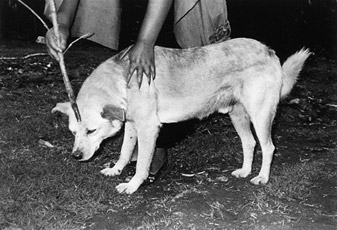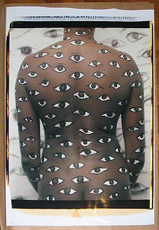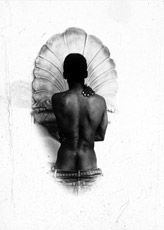II
The presence of Ana Mendieta in an exhibition or in a photography collection is always a good excuse to revisit the theme of the importance that performance art and ephemeral art have had for the inclusion of photography in contemporary art, from the time of Conceptualism to the present. This was how a crack in its alleged specificity and the autonomy of the photographic language was generated, which was first seen in more complex and plural aesthetic systems. In the context of this analysis, it is also a good excuse, to illustrate with concrete examples, the recent increasing contamination of the photographic image by this spiritual element I have mentioned.
If I were to mention a strong and indisputable precedent of this close and problematic relationship between the representation of the body and the intuition of the sacred in the current photographic practice, I would definitely comment on the work of Ana Mendieta.1
I understand this intuition of the sacred as a key for the unfolding of much more dramatic affective relationships between the subject and his reality. This affective, dramatized -or sometimes-ritualized- component gives a very particular nuance to methodologies that apparently are so close to the anthropologic investigation.
Regarding photography, the work of Ana Mendieta is a good reference for the revision of the representation processes, for the reformulation of the place occupied by the body in those processes. And specially, for the contextualization of a ““performatic” ” element that is crucial in a big part of contemporary art. |
 © Ana Mendieta |
I want to understand “performatic” in two senses. First, referring to a procedure character of the work of art, which puts the very concept of work in crisis as a definitive object, and thus static. From that point of view, even when facing photography as a definitive object, we are forced to invert its logic and locate the elements of the process that construct it and give dynamism to its time-space structure within its structure of meanings.
To do that, it must be understood that such elements constitute an exercise of representation previous to the photographic act, although they infiltrate photography, preventing it from stabilizing and becoming a definitive object. The staging, acting or representations of what will be photographed, constitute aesthetic and ideological constructions. These events will charge the photo with an internal energy that will also decrease its autonomy and self-sufficiency.
Secondly, the “performatic” refers precisely to such energy, which is also directed to the re thinking of the traditional statements by which the photographic was evaluated and defined as such, but also as an art. In fact the “performatic” can be located in that trend and that possibility that contemporary art uses to evaluate, criticize and define itself. This is something that is also a process and also resists the logic that might be imposed by the definitive object.
In both cases the “performatic” is a privileged way for the fusion of subjectivity within the objectivity of the work of art, and one of the mechanisms by which the ideologization of the contemporary artistic object has been constructed. The relationship with a photographic image that reproduces the apparently sculpture-like results of a “performatic” process would include an imaginary dissolution of the photographic object and an inclusion of the performance art among its referents. It would force to live the process and the acts previous to the photo imaginarily. To quote Rosalind Kraus, we could say that if in the “expanded field” of the sculpture we can find the installation, in the expanded field of photography we can find the performance art.
|
This is basically the way in which the work of Marta Maria Perez operates, in which is not difficult to find connections with the work of Ana Mendieta. In Marta Maria Perez ‘s work the “performatic” element not only belongs to a pre-photographic moment, but it is also included in the picture as a technical moment and as a structure of meanings (as a text we might say). |
This shapes the work in a way that invites us to get closer to it through more complex ways than those accepted by the traditional documentary photographic work. The works of Marta Maria Perez not only renounce to define themselves as documentary photos, but also to make the statement of being testimonies of a strictly photographic technique. Then, the value of the photo as an object, does not depend of its capacity to exhibit the marks of a refined craft or technical proficiency in an inert manner. Its meaning would be incomplete if its “performatic” element were not accounted for, which suggests the potential social operativeness of the work that is outside the traditional limits of the photographic object.
That operativeness no longer has to do with the ways in which the photo reproduces the image of a subject or an object, but rather with its capacity to reproduce relationships between subjects and objects, established coded relationships that are, in a way, ritualized within a specific cultural context. In Marta Maria Perez’s case, it has been mainly about the magical-fetishist relationships that Afro-Cuban religions operate with. In the case of Maruch Sántiz, we would be talking about the importance of the taboo to establish order and give meaning to the subject-object relationships in certain communities. Another variety is Milagro de la Torre’s, who began in the object-evidence, in which the primary function is to identify, but also to accuse. In the end, it’s an imaginary reconstruction of an absent subject, starting from the detection of the subjectivity in a residual objectivity.
 |
 |
"To prevent a dog from catching rabies" © Maruch Sántiz |
"The lost steps" © A reporter's shirt Camisa de periodista murdered in the massacre Ucchuracay, 1996. |
I do not witch to get to speculate about the feminine role in the symbolic re-thinking of objects and bodies, but especially in the case of Maruch Sántiz, she defines the gender of objects, functions and meanings she works with. At any rate, if I were to stress that other variety of emphasis, I should add the names of Cirenaica Moreira and Priscilla Monge, who do explore the social and symbolic function of the feminine, the sexist paradigms of representation and the dominating role playing in the consumption of the image. They turn such exploration into a provoking and confrontational resource, but also into an exercise of self-enunciation and an experience of identification. I should also mention the work of Maria Magdalena Campos, but stressing that her representation of identity, as a visual construction, is always perceptible in her record of her racial identity.
That is why the work of Maria Magdalena Campos can have coincidences with a work such as Rene Peña’s. Notwithstanding the differences in methodology, or the fact that one artist is male and the other one female. Both have worked simultaneously, very worried that racial and sexual stereotypes that determine the consumption and even the production of images. Both have played with staging and the simultaneous dissolution and reaffirmation of their identities.
|
|
1. Of course I am not talking about Ana Mendieta as a photographer or th her work as being “photographic”. However the ephemeral character of most of her actions and the fact that they were documented in photos make photography the final “receptacle” of the meanings and purposes of her work. Mendieta’s work is “told” by photographs, and I dare to suspect that theri final destination was forseen by the author. The photographic work was not an emergency resource but a component of its methodology. We can speculate that performance art, like any contemporary public spectacle,is destined to photography and that probably, photography adds the definitive touch so the event can be understood as a spectacle


